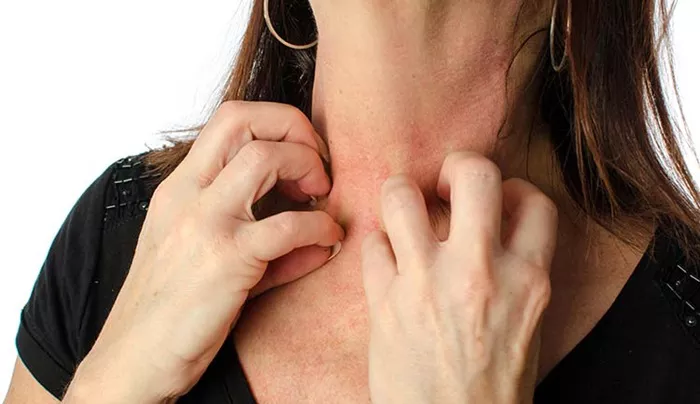Ragweed is a common allergenic plant that can trigger allergic reactions in susceptible individuals. Exposure to ragweed pollen can lead to a range of symptoms, including a skin rash known as ragweed rash or allergic contact dermatitis. This article explores what ragweed rash looks like, its symptoms, causes, and treatment options to help individuals recognize and manage this allergic skin condition.
What is Ragweed Rash?
Ragweed rash, also known as allergic contact dermatitis, is a type of skin reaction that occurs when the skin comes into contact with ragweed pollen or its extracts. It is an allergic reaction characterized by inflammation, redness, itching, and sometimes blistering or oozing of the affected skin.
Symptoms of Ragweed Rash
Redness and Inflammation
One of the primary symptoms of ragweed rash is redness and inflammation of the skin. The affected area may appear swollen, warm to the touch, and irritated.
Itching and Irritation
Ragweed rash typically causes intense itching and irritation of the skin. Individuals may experience a strong urge to scratch the affected area, which can exacerbate the symptoms and lead to further inflammation.
Blisters and Oozing
In severe cases, ragweed rash may result in the formation of blisters on the skin. These blisters may contain fluid and can rupture, leading to oozing and crusting of the affected area.
Dry, Scaly Skin
Chronic or recurrent exposure to ragweed pollen can cause the skin to become dry, scaly, and rough. This may result in a persistent rash that flares up during ragweed season or upon exposure to allergens.
Secondary Infections
Repeated scratching of the affected skin can increase the risk of secondary bacterial or fungal infections. Signs of infection may include increased redness, warmth, swelling, pain, and the presence of pus or drainage.
What Does Ragweed Rash Look Like?
Appearance of the Rash
Ragweed rash typically presents as a red, inflamed patch of skin. The affected area may vary in size and shape, depending on the extent of exposure to ragweed pollen and individual susceptibility.
Location of the Rash
Ragweed rash commonly occurs on areas of the body that come into direct contact with ragweed pollen or its extracts. This may include:
Hands and Forearms: Individuals who handle ragweed plants or contaminated objects may develop rash on their hands and forearms.
Face and Neck: Facial rash may occur in individuals who touch their face after handling ragweed or inhale pollen particles that come into contact with the skin.
Legs and Feet: Contact with ragweed pollen while walking or gardening barefoot may lead to rash on the legs and feet.
Texture of the Rash
The texture of ragweed rash may vary depending on the severity of the reaction. In mild cases, the rash may appear as red, raised bumps or patches of skin. In more severe cases, the skin may become blistered, cracked, or scaly.
Other Associated Symptoms
In addition to the characteristic appearance of the rash, individuals with ragweed rash may experience other symptoms such as itching, burning, or stinging of the affected skin. These symptoms may range from mild to severe and can significantly impact quality of life.
Causes of Ragweed Rash
Ragweed Pollen Exposure
The primary cause of ragweed rash is exposure to ragweed pollen. Ragweed plants release pollen grains into the air during the late summer and early fall months, typically from August to October in many parts of the world. Inhalation or direct contact with ragweed pollen can trigger an allergic reaction in susceptible individuals.
Allergic Sensitization
Allergic contact dermatitis occurs when the immune system overreacts to a specific substance, in this case, ragweed pollen. Individuals who are sensitized to ragweed pollen through previous exposure may develop an allergic reaction upon subsequent contact.
Cross-Reactivity
Some individuals may experience cross-reactivity between ragweed pollen and certain foods, such as bananas, melons, and zucchinis. This phenomenon, known as oral allergy syndrome, can lead to allergic reactions in the mouth and throat, as well as skin rash in some cases.
Preexisting Skin Conditions
Individuals with preexisting skin conditions, such as eczema or atopic dermatitis, may be more susceptible to developing ragweed rash. The compromised skin barrier in these conditions can make the skin more vulnerable to allergens and irritants.
Diagnosis of Ragweed Rash
Clinical Evaluation
Diagnosing ragweed rash typically involves a thorough clinical evaluation by a healthcare provider. The provider will assess the appearance and location of the rash, inquire about symptoms and potential triggers, and review the individual’s medical history.
Skin Patch Testing
In some cases, skin patch testing may be performed to identify specific allergens that trigger allergic contact dermatitis. During this test, small amounts of common allergens, including ragweed pollen extracts, are applied to the skin and covered with adhesive patches. The patches are left in place for a period of time, usually 48 hours, to observe any allergic reactions.
Allergy Testing
Allergy testing, such as skin prick testing or blood tests, may also be recommended to identify sensitivities to ragweed pollen or other allergens. These tests can help confirm the diagnosis and guide treatment decisions.
Treatment of Ragweed Rash
Avoidance of Ragweed Pollen
The most effective way to prevent ragweed rash is to avoid exposure to ragweed pollen. This may include staying indoors during peak pollen times, keeping windows closed, using air purifiers, and wearing protective clothing when outdoors.
Topical Treatments
Mild cases of ragweed rash may be treated with over-the-counter topical corticosteroid creams or ointments to reduce inflammation and itching. Antihistamine creams or lotions may also provide relief from itching.
Oral Medications
In cases of moderate to severe ragweed rash, oral antihistamines or corticosteroids may be prescribed to alleviate symptoms and reduce inflammation. These medications may be used on a short-term basis to manage acute flare-ups.
Wet Compresses
Applying cool, wet compresses to the affected skin can help soothe inflammation and reduce itching. Compresses can be made using clean, damp cloths or gauze pads applied to the rash for 15-20 minutes at a time.
Avoiding Irritants
Individuals with ragweed rash should avoid known irritants or triggers that can exacerbate symptoms. This may include harsh soaps, fragranced products, and abrasive fabrics that can further irritate sensitive skin.
Moisturizers
Regular use of moisturizing creams or ointments can help hydrate the skin and maintain its natural barrier function. Moisturizers should be applied immediately after bathing or showering to lock in moisture.
Prescription Treatments
In severe or refractory cases of ragweed rash, prescription-strength topical corticosteroids, immunomodulators, or oral medications may be necessary. These treatments should be prescribed and monitored by a healthcare provider.
Conclusion
Ragweed rash, or allergic contact dermatitis, is a common allergic skin reaction that occurs in response to exposure to ragweed pollen. Recognizing the symptoms and triggers of ragweed rash is essential for effective management and prevention. By taking proactive measures to minimize exposure to ragweed pollen and implementing appropriate treatment strategies, individuals can reduce the frequency and severity of ragweed rash flare-ups and improve their quality of life. Consulting a healthcare provider for an accurate diagnosis and personalized treatment plan is recommended for individuals with ragweed allergy or suspected ragweed rash.
[inline_related_posts title=”You Might Be Interested In” title_align=”left” style=”list” number=”6″ align=”none” ids=”9329,9326,9308″ by=”categories” orderby=”rand” order=”DESC” hide_thumb=”no” thumb_right=”no” views=”no” date=”yes” grid_columns=”2″ post_type=”” tax=””]
































